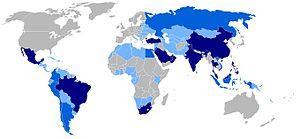Kuala Lumpur ranked way down in Reader’s Digest latest appraisal
PETALING JAYA: Some things do not seem to change in Malaysia and foremost among them are rudeness and inconsiderate behaviour.
Six years ago, Reader's Digest placed Malaysia's rudeness level at 33 out of the 35 countries ranked.
The latest appraisal by the magazine shows Kuala Lumpur almost at the bottom of a list of Least Courteous Cities at number 34 out of 36 major cities in the world.
 So impatient: Commuters trying to get into a train even before other passengers have alighted. Police records show that more than 20% of the 1.3 million accidents yearly result from aggressive driving behaviour but inconsiderate and risky conduct on the roads remain the main complaints, according to findings in The Star Online's Facebook page (www.facebook/thestaronline) survey.
So impatient: Commuters trying to get into a train even before other passengers have alighted. Police records show that more than 20% of the 1.3 million accidents yearly result from aggressive driving behaviour but inconsiderate and risky conduct on the roads remain the main complaints, according to findings in The Star Online's Facebook page (www.facebook/thestaronline) survey.
Other selfish acts like ignoring signs against smoking, eating and littering, and rushing in to lifts, trains and buses before allowing people to exit are also high on the list.
Poor toilet etiquette, talking loudly on phones even in cinemas, being late for appointments, not saying “thank you” and leaving trolleys in parking lots are the other bad habits that Malaysians continue to practise shamelessly.
Academic counsellor Joshua Johnson, 31, said the most common examples of bad drivers were those who did not use indicator lights when switching lanes and tailgating road bullies.
Christopher Oh, 25, a research assistant, said he was peeved by smokers who disregarded no-smoking signs in enclosed areas.
Describing them as rude public hazards, he said: “Smoking in a non-smoking area is thoughtless and irresponsible because second-hand smoke is harmful, especially to non-smokers,” he said.
Kevin Mcintyre, a Scottish expatriate working in Kuala Lumpur, said he missed his stop on the train because people were rushing into it as he was trying to get out.
“It was rude and caused me a great inconvenience,” he said.
A Keretapi Tanah Melayu Berhad spokesman confirmed that such uncaring attitude was common, especially during rush hours.
“Passengers also do not readily offer their seats to pregnant, handicapped or elderly passengers,” he added.
He said that during off-peak periods, there were also male passengers who indiscriminately boarded coaches reserved for women, ate on board, smoked and also littered.
In GEORGE TOWN, Penang Senior Citizens Association president Lawrence Cheah noted that young Malaysians were not as polite as their Singaporean counterparts.
“In Singapore, they willingly give up their seats on public transport,” he said.
He said that despite the higher level of literacy, people seemed to have adopted a less caring attitude.
“In the old days, people were more civic-minded, although they were not as highly educated as today,” he added.
Eden Handicap Service Centre assistant unit head S.K. Lee said it was meaningless to be highly educated if one behaved rudely.
“Parking in lots for the disabled and using public toilets meant for such people is very bad and rude behaviour,” he said.
Reports by YVONNE LIM,QISHIN TARIQ and CHRISTINA CHIN, The Star/Asia News Network
PETALING JAYA: Some things do not seem to change in Malaysia and foremost among them are rudeness and inconsiderate behaviour.
Six years ago, Reader's Digest placed Malaysia's rudeness level at 33 out of the 35 countries ranked.
The latest appraisal by the magazine shows Kuala Lumpur almost at the bottom of a list of Least Courteous Cities at number 34 out of 36 major cities in the world.
Other selfish acts like ignoring signs against smoking, eating and littering, and rushing in to lifts, trains and buses before allowing people to exit are also high on the list.
Poor toilet etiquette, talking loudly on phones even in cinemas, being late for appointments, not saying “thank you” and leaving trolleys in parking lots are the other bad habits that Malaysians continue to practise shamelessly.
Click on image to view bigger image.
Christopher Oh, 25, a research assistant, said he was peeved by smokers who disregarded no-smoking signs in enclosed areas.
Describing them as rude public hazards, he said: “Smoking in a non-smoking area is thoughtless and irresponsible because second-hand smoke is harmful, especially to non-smokers,” he said.
Kevin Mcintyre, a Scottish expatriate working in Kuala Lumpur, said he missed his stop on the train because people were rushing into it as he was trying to get out.
“It was rude and caused me a great inconvenience,” he said.
A Keretapi Tanah Melayu Berhad spokesman confirmed that such uncaring attitude was common, especially during rush hours.
“Passengers also do not readily offer their seats to pregnant, handicapped or elderly passengers,” he added.
He said that during off-peak periods, there were also male passengers who indiscriminately boarded coaches reserved for women, ate on board, smoked and also littered.
In GEORGE TOWN, Penang Senior Citizens Association president Lawrence Cheah noted that young Malaysians were not as polite as their Singaporean counterparts.
“In Singapore, they willingly give up their seats on public transport,” he said.
He said that despite the higher level of literacy, people seemed to have adopted a less caring attitude.
“In the old days, people were more civic-minded, although they were not as highly educated as today,” he added.
Eden Handicap Service Centre assistant unit head S.K. Lee said it was meaningless to be highly educated if one behaved rudely.
“Parking in lots for the disabled and using public toilets meant for such people is very bad and rude behaviour,” he said.
Reports by YVONNE LIM,QISHIN TARIQ and CHRISTINA CHIN, The Star/Asia News Network






